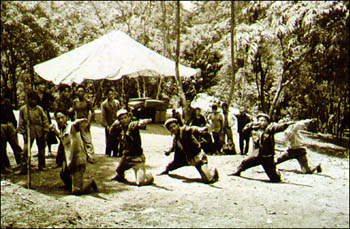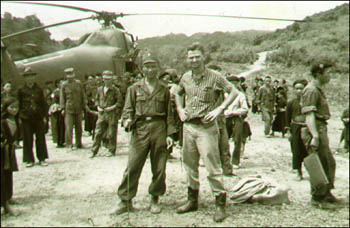The Hmong and Others Mourn Vang Pao
Thursday, February 3, 2011

After the CIA’s Special Activities Division in the country of Laos trained an ethnic group of people called the Hmong to fight, the group launched into a series of military engagements against both North Vietnam during the Vietnam War and communist leader Pathet Lao’s military. Tasked with the duty to help guard the primary military supply route called the Ho Chi Minh Trail and fight against the Communists in their own country (later to be known as the “Secret War”), the Hmong people did what they could with the help of the CIA during this period in the Cold War.
Things took a turn for the worse for the Hmong people after U.S. forces abandoned the Vietnam War, leaving countless South Vietnamese and Hmongs behind. Once Pathet Lao took power in Laos, government reprisals against the Hmong and other ’anti-communists’ raged without check. Often those who escaped bullets ran into “re-education” camps and the horrors of slave labor. Those who were fortunate enough to escape went into hiding in the mountains of Laos or neighboring Thailand. Later, some found their way to the United States or went to other countries through controversial repatriation.
Throughout the years, one man became the symbol of resistance, justice and nobleness for the oppressed and scattered Hmong and that man’s name was Vang Pao, a Hmong himself.
Vang Pao had become cruelly introduced to war at the tender age of 15 when he fought against invading Japanese soldiers in World War II.
Then a Major General of the Royal Lao Army, Vang Pao led Hmong guerillas in countless military and rescue operations that undoubtedly saved hundreds of American and Vietnamese lives. Many who fought with Pao described him as a charismatic military leader who could turn the tides of battle simply by being present. Vang Pao was declared by many as a true war hero and even former CIA Chief William Colby called him the “biggest hero” of the Vietnam War.

Hmong fighters training to use grenades.

Vang Pao (left)
To most of the world, Vang Pao and the Secret War are unfortunately not well-known, buried by the bigger picture of the Cold War, other pressing current events and in recent years, certain governments.
However, Vang Pao is venerated by most Hmong communities as the people’s hero, a “father” or “grandfather”. Yet, tragically for the Hmong people, Vang Pao died of pneumonia on the 6th of January, 2011.
Although Vang Pao was surrounded by allegations of a conspiracy to overthrow the Laos government and other things near his end, countless Hmong upheld him as both an innocent and courageous man who fought for Hmong and the world.
Vang Pao inspired thousands of Hmong in different generations in the United States by closely working with people to help the Hmong adapt to the American life. He encouraged education in all communities and told the people to “never forget” their dreams and rights.
Vang Pao helped many Hmong communities including one of the largest Hmong populations in present-day Fresno, California by assisting them learn English and by lowering down crime rates in the younger Hmong population.
As a people and those who still remember Vang Pao mourn him, efforts are being made to bury Vang Pao in the Arlington National Cemetery. U.S. veterans who remember Vang Pao or at least have heard of him and his deeds are backing up Pao’s family’s wishes to have him laid to rest in the Arlington National Cemetery. As of this time it is unknown whether or not Vang Pao will be buried in the cemetery but mourning still continues as traditional Hmong funeral rites draw near this week. More than 1,000 are expected to attend his funeral lasting from February 4th to February 9th in Fresno.
(Cover Photo: Gary Kazanjian/AP/File)
Source


0 hlub:
Post a Comment